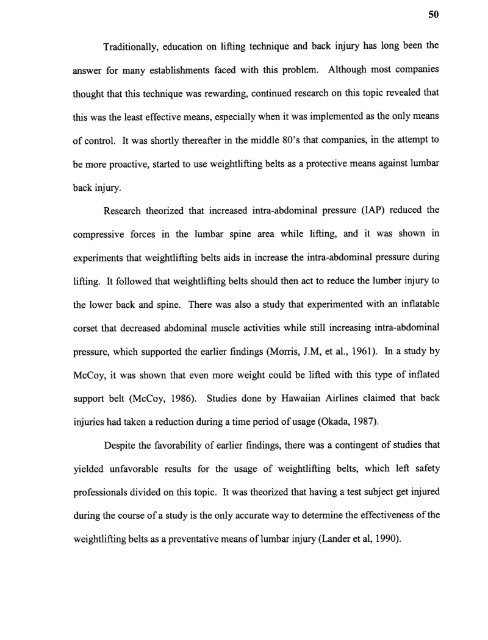An ergonomic assessment of the airline baggage handler
An ergonomic assessment of the airline baggage handler
An ergonomic assessment of the airline baggage handler
You also want an ePaper? Increase the reach of your titles
YUMPU automatically turns print PDFs into web optimized ePapers that Google loves.
50Traditionally, education on lifting technique and back injury has long been <strong>the</strong>answer for many establishments faced with this problem. Although most companiesthought that this technique was rewarding, continued research on this topic revealed thatthis was <strong>the</strong> least effective means, especially when it was implemented as <strong>the</strong> only means<strong>of</strong> control. It was shortly <strong>the</strong>reafter in <strong>the</strong> middle 80's that companies, in <strong>the</strong> attempt tobe more proactive, started to use weightlifting belts as a protective means against lumbarback injury.Research <strong>the</strong>orized that increased intra-abdominal pressure (lAP) reduced <strong>the</strong>compressive forces in <strong>the</strong> lumbar spine area while lifting, and it was shown inexperiments that weightlifting belts aids in increase <strong>the</strong> intra-abdominal pressure duringlifting. It followed that weightlifting belts should <strong>the</strong>n act to reduce <strong>the</strong> lumber injury to<strong>the</strong> lower back and spine. There was also a study that experimented with an inflatablecorset that decreased abdominal muscle activities while still increasing intra-abdominalpressure, which supported <strong>the</strong> earlier findings (Morris, J.M, et al., 1961). In a study byMcCoy, it was shown that even more weight could be lifted with this type <strong>of</strong> inflatedsupport belt (McCoy, 1986). Studies done by Hawaiian Airlines claimed that backinjuries had taken a reduction during a time period <strong>of</strong> usage (Okada, 1987).Despite <strong>the</strong> favorability <strong>of</strong> earlier findings, <strong>the</strong>re was a contingent <strong>of</strong> studies thatyielded unfavorable results for <strong>the</strong> usage <strong>of</strong> weightlifting belts, which left safetypr<strong>of</strong>essionals divided on this topic. It was <strong>the</strong>orized that having a test subject get injuredduring <strong>the</strong> course <strong>of</strong> a study is <strong>the</strong> only accurate way to determine <strong>the</strong> effectiveness <strong>of</strong> <strong>the</strong>weightlifting belts as a preventative means <strong>of</strong> lumbar injury (Lander et al, 1990).
















